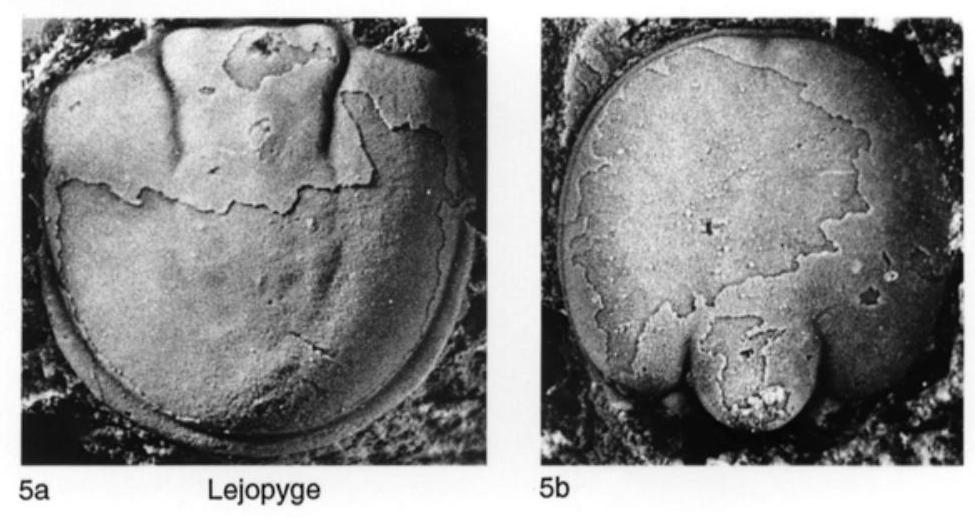Welcome to the Treatise on Invertebrate Paleontology!
Please enter a genera name to retrieve more information.

Tomagnostus
Classification
Phylum:
Arthropoda
Class:
Trilobita
Order:
Agnostida
Superfamily:
Agnostoidea
Family:
Ptychagnostidae
Formal Genus Name and Reference:
Tomagnostus HOWELL, 1935c, p. 15
Type Species:
Agnostus fissus Lundgren in Linnarsson, 1879, p. 23, OD, neotype (SD WESTERGÅRD, 1946, pl. 7, fig. 22), 4840, SGU, Uppsala
Images
(Click to enlarge in a new window)
Fig. 224,3a,b. *T. fissus (LUNDGREN), Middle Cambrian (Triplagnostus gibbus Zone), Sweden (south of Brantevik, Skåne); a, neotype, cephalon, SGU 4840, ×9; b, topotype, pygidium, SGU 4839, ×9 (new).
Synonyms
Geographic Distribution
USA (South Carolina); Sweden, Denmark, England, T. gibbus to H. parvifrons Zones; Russia (Siberia), Kounamkites, Pseudanomocarina, T. fissus-P. hicksi to A. henrici Zones; Canada (Newfoundland), P. hicksi to P. davidis Zones; Czechoslovakia, E. pusillus Zone; Australia (Northern Territory), ? A. atavus Zone.
Age Range
Beginning Stage in Treatise Usage:
Middle Cambrian
Beginning International Stage:
Cambrian Stage 4
Fraction Up In Beginning Stage:
40
Beginning Date:
512.3
Ending Stage in Treatise Usage:
Middle Cambrian
Ending International Stage:
Guzhangian
Fraction Up In Ending Stage:
50
Ending Date:
498.75
Description
usually scrobiculate, borders of moderate width, nonspinose or with small pygidial marginal spines, median preglabellar furrow commonly weakly developed, anterior glabellar lobe subquadrate to semiovate, usually sulcate, posterior glabellar lobe usually with well-developed F2 furrows, axial glabellar node elongate, from a short distance behind to in front of F2 furrows, basal lobes slightly elongate, commonly indistinct anteriorly, pygidial axis with well-developed F2 furrows, moderate to small node on M2, posterior lobe with well-developed transverse depression near midlength, median postaxial furrow rarely present, weak, narrow (sag.) pygidial collar present in some specimens
References
Museum or Author Information
Classification
Phylum:
Arthropoda
Class:
Trilobita
Order:
Agnostida
Superfamily:
Agnostoidea
Family:
Ptychagnostidae
Formal Genus Name and Reference:
Tomagnostus HOWELL, 1935c, p. 15
Type Species:
Agnostus fissus Lundgren in Linnarsson, 1879, p. 23, OD, neotype (SD WESTERGÅRD, 1946, pl. 7, fig. 22), 4840, SGU, Uppsala
Images
(Click to enlarge in a new window)
Fig. 224,3a,b. *T. fissus (LUNDGREN), Middle Cambrian (Triplagnostus gibbus Zone), Sweden (south of Brantevik, Skåne); a, neotype, cephalon, SGU 4840, ×9; b, topotype, pygidium, SGU 4839, ×9 (new).
Synonyms
Geographic Distribution
USA (South Carolina); Sweden, Denmark, England, T. gibbus to H. parvifrons Zones; Russia (Siberia), Kounamkites, Pseudanomocarina, T. fissus-P. hicksi to A. henrici Zones; Canada (Newfoundland), P. hicksi to P. davidis Zones; Czechoslovakia, E. pusillus Zone; Australia (Northern Territory), ? A. atavus Zone.
Age Range
Beginning Stage in Treatise Usage:
Middle Cambrian
Beginning International Stage:
Cambrian Stage 4
Fraction Up In Beginning Stage:
40
Beginning Date:
512.3
Ending Stage in Treatise Usage:
Middle Cambrian
Ending International Stage:
Guzhangian
Fraction Up In Ending Stage:
50
Ending Date:
498.75
Description
usually scrobiculate, borders of moderate width, nonspinose or with small pygidial marginal spines, median preglabellar furrow commonly weakly developed, anterior glabellar lobe subquadrate to semiovate, usually sulcate, posterior glabellar lobe usually with well-developed F2 furrows, axial glabellar node elongate, from a short distance behind to in front of F2 furrows, basal lobes slightly elongate, commonly indistinct anteriorly, pygidial axis with well-developed F2 furrows, moderate to small node on M2, posterior lobe with well-developed transverse depression near midlength, median postaxial furrow rarely present, weak, narrow (sag.) pygidial collar present in some specimens
